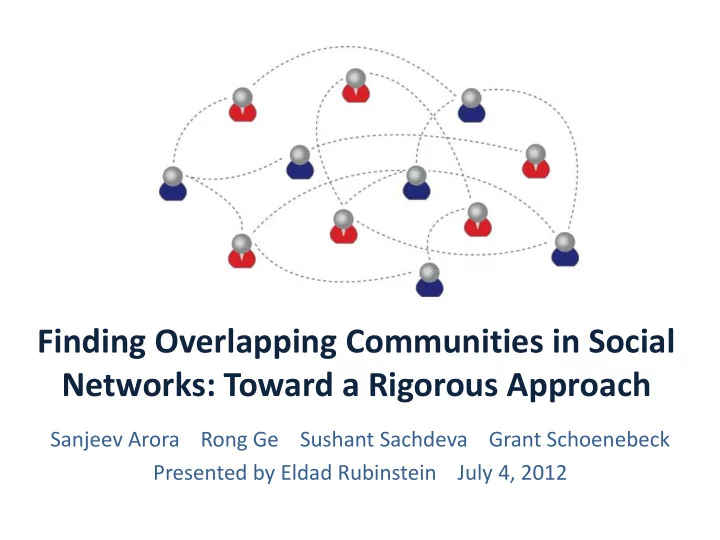

Finding Overlapping Communities in Social Networks: Toward a Rigorous Approach Sanjeev Arora Rong Ge Sushant Sachdeva Grant Schoenebeck Presented by Eldad Rubinstein July 4, 2012
Introduction • What is a community in a social network? – a group of nodes more densely connected with each other than with the rest of the network • Communities overlap each other • Direct approach NP-hard problems • Heuristic or generative model approach egg & chicken problem • Instead: Assumptions are based on ego-centric networks – Studied in sociology – Suggested algorithms also have ego-centric analysis feel 2
Assumptions 0. Each person participates in up to d communities – d is constant or small 1. Expected degree model – Each node u in community C has an affinity – The edge (u,v) exists with probability 2. Maximality with gap – If for u,v , (u,v) exists with probability , then w has edges to fraction of nodes in C 3. Communities explain fraction of each person ties 3
First Step: Communities are Cliques • Another Assumption: • Output each community with prob. – in time • Algorithm Description 1. Pick starting nodes uniformly at random 2. For each starting node v , randomly sample 3. Look at cliques U in G(S) 4. Let V’ be the set of nodes in which are connected to all nodes in U 5. Return high degree vertices from G(V’) 4
Communities are Dense Subgraphs • Setup 1: – Find each community • With high probability over G randomness • With prob. 2/3 over algorithm randomness • In time • Setup 2: – Need to loop over all of size T • Sample for each S – Worse running time: 5
Communities with Very Different Sizes • Sampling may miss small communities – So previous ideas will not work • Definition: A is a -set if – Nodes in A have edges to fraction of nodes in A – Outside nodes have edges to fraction of nodes in A • Algorithm (assuming ) 1. For downto step 1.1. For all sets of nodes S of size T 1.1.1. U = { v : fraction of its edges are to S } 1.1.2. Return U if it is a set • Running time: (not polynomial) 6
Cliques with Very Different Sizes • Looking for a polynomial algorithm for cliques • Extra assumptions are needed: – Distinctness: For , at least a constant factor of C does not lie in any other community containing u – Duck assumption – Small communities are distinguishable from “noise” edges • Polynomial algorithm description – Find large cliques first (sampled easily), then ignore their edges – Extra assumptions ensure smaller cliques can be found 7
Relaxing the Assumptions • Expected degree model assumption can be relaxed if: – The following are concentrated near their expectation: • # of edges from any node u to any community C • Degree of each node • Intersection of two nodes in a community • Gap assumption – Can be relaxed if: • • Communities are cliques or – The returned communities will be close to the real ones 8
Sparser Communities • Different assumptions – (u,v) exists with probability (where ) – All edges belong to some community – Communities intersection size is limited • Transform G to a dense graph G’ – Nodes are the same – (u,v) exists in G’ iff they have length-2 path in G 9
Summary extra / probability of communities case running different edges in sizes must be no. time assumptions? communities similar? 1 No Cliques Yes Polynomial 2 No Yes Polynomial 3 No Yes Polynomial 4 No No Quasi-Poly 5 Extra Cliques No Polynomial 6 Different Sparse Yes Polynomial 10
Areas of Possible Further Research • Releasing the assumptions in more cases – Expected degree model assumption – Maximality (gap) assumption • Polynomial algorithm for dense communities with different sizes • Fast implementation using heuristics • Testing on real-world data • Adapting the algorithms to a dynamic setting 11
Questions?
Recommend
More recommend